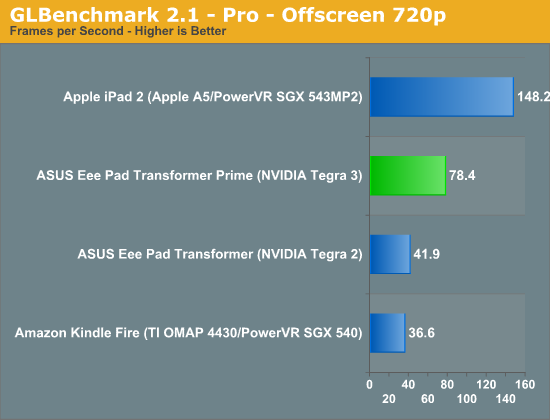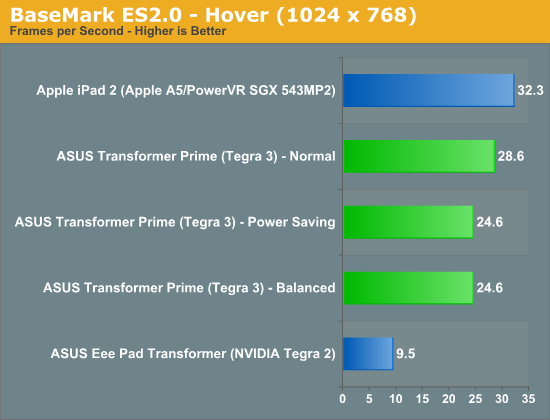ASUS Eee Pad Transformer Prime & NVIDIA Tegra 3 Review
by Anand Lal Shimpi on December 1, 2011 1:00 AM ESTTegra 3 GPU: Making Honeycomb Buttery Smooth
The bigger impact on the overall experience is the Tegra 3's GPU. If you remember back to our initial analysis of Tegra 3 you'll know that the GPU is not only clocked higher but it also has more execution resources at its disposal. To further improve performance, per "core" efficiency is up thanks to some larger internal data structures and tweaks. The end result is much better gaming performance as well as a much smoother UI.
Tasks like bringing up the apps launcher or even swiping between home screens are finally far above 30 fps. While Tegra 2 didn't have the fill rate to deal with some of the more complex overlays in Honeycomb, Tegra 3 does. The move to Tegra 3 makes the Honeycomb experience so much better. This is what it should've been like from the start.
Gaming performance is also significantly better as you can see from our standard collection of Android GPU benchmarks:




Performance is still not quite up to par with the iPad 2, but if we look at GLBenchmark's Egypt test Tegra 3 doesn't do too bad. The gap grows in more texture bound tests but in a heavier shader environment Tegra 3 isn't too shabby. While it's clear that Tegra 2 wasn't enough to deal with the 1280 x 752 resolution of Honeycomb tablets, Tegra 3 seems well matched.
Note that the BaseMark ES2.0 tests run at FP16 on Tegra 2 and 3 vs. FP24 on the PowerVR SGX 543MP2.










204 Comments
View All Comments
MiSoFine - Thursday, December 1, 2011 - link
my 2 cents...get a Kindle fire. Easier UI for non tech parents & it's still android; cheaper also. Or a Vizio vTab.I got my Mom a Kindle Fire, kids a vTab (they will at least attempt to try to figure it out) & myself a (preordered) Prime.
steven75 - Saturday, December 3, 2011 - link
Considering the complete lack of Android tablet apps, that doesn't seem wise.Enkur - Thursday, December 1, 2011 - link
What is that android app that shows the per core CPU activity in the screenshot above?Lucian Armasu - Thursday, December 1, 2011 - link
Anand, just remember to note, or even test the real world performance when iPad 3 and other high resolution tablets arrive.In your benchmarks they should be showing even faster performance at 720p with the upcoming faster chips, but that might not be the case in the real world. Remember how low FPS the iPhone 4 got with its 4x the resolution over iPhone 3GS, when tested at native resolution?
That should be happening to iPad 3 and the others, too, even if the chips get faster by then. I would wait until at least 2013 to get a 2k resolution tablet, so I won't be that significantly impacted by it.
Lucian Armasu - Thursday, December 1, 2011 - link
Also is there a way to compare the graphics between Tegra 3 and iPad 2 without comparing the benchmark numbers? Like comparing the best graphics on Tegra 3 versus the best one on iPad 2, and notice the differences between them? I really don't think the benchmark numbers tell the whole truth.I think Tegra 3 games may even look/work better than A5 games, thanks to its quad core CPU, too, but I figure you should be able to tell that better than me since you have both.
vision33r - Thursday, December 1, 2011 - link
I disagree, in PC and Console world, the GPU is the determining factor in game graphics and performance.You can take a Core i7 using HD3000 integrated graphics and compare it with a Core i3 with an ATI 4850 and it will spank the Core i7 in gaming performance.
That's what's happening here is the Tegra 3's GPU is underwhelming from a graphics chip maker.
Very few mobile games imo need even dual core, they need the proper graphics acceleration and that's where Android fragmentation has hurt game development.
They have to code games for the lowest common denominator instead of optimizing games for Tegra.
metafor - Thursday, December 1, 2011 - link
That doesn't necessarily translate to the mobile world. On the desktop side, CPU's have gotten so fast that just about any task a game can throw at it -- physics, AI, audio, etc. -- can be done without bottlenecking the game while the shading/rendering on the GPU is still being pushed.On the mobile side, this may not be true (yet) as the CPU's are -- comparatively -- fairly underpowered against their desktop counterparts. Couple this with the fact that the GPU is taxed to push out less pixels and one could easily see situations where the CPU becomes the bottleneck.
As mobile CPU's get faster -- especially with the A15/Krait generation -- this will become less and less of an issue especially as games make use of NEON to do their computationally heavy tasks and we'll get to a point where the GPU is the only bottleneck left.
But I don't see that happening until we hit the ~2.5GHz dual A15/Krait level.
vision33r - Thursday, December 1, 2011 - link
Very few Android games that I've seen are properly optimized unless they got that Optimized for Tegra logo. Otherwise most games do not take advantage of GPU acceleration.On iOS almost all games has some sort of GPU assist. Take Plants vs Zombies, the iOS version is perfect. The Android HD version has lower animation and graphics.
Almost all Gameloft games perform smoother on iOS than on Android.
metafor - Thursday, December 1, 2011 - link
Well yes. But the point is that with a higher performance CPU or group of CPU's, it is possible to have things that would be bottlenecked in a mobile device -- such as physics, AI, etc. -- be more complex and provide better visuals.Whether or not that has been done is another story. But you can hardly blame application devs for pouring more focus into iOS. The iPad is still what, ~90% of the tablet market? Moreover the App Store brings in way more revenue -- which the developers get a cut of -- than Android Market has thus far.
That will hopefully change over time.
steven75 - Saturday, December 3, 2011 - link
The problem with that theory is iPhones still bring in vastly more revenue for developers than android phones, despite the latter having higher market share.